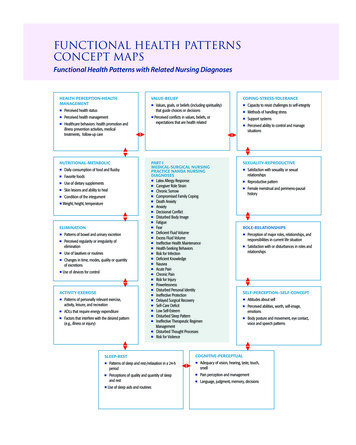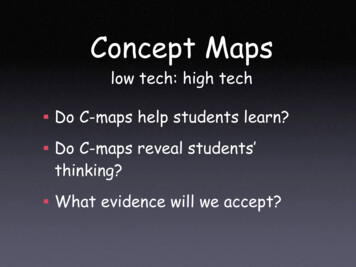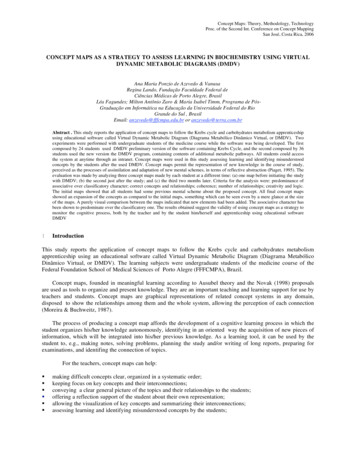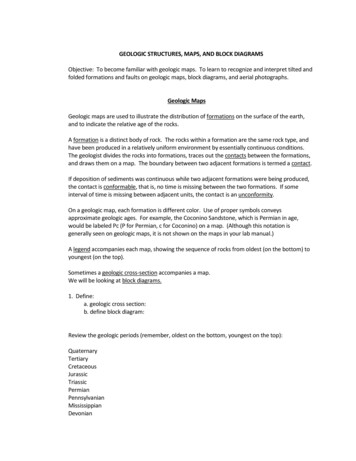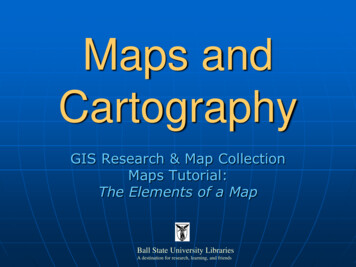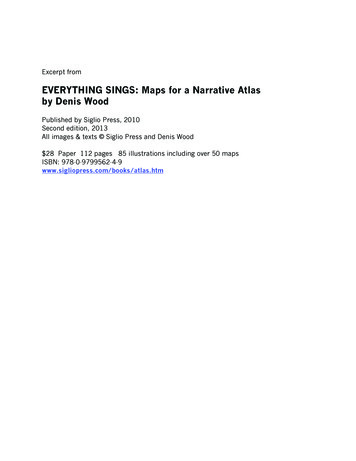
Transcription
Excerpt fromEVERYTHING SINGS: Maps for a Narrative Atlasby Denis WoodPublished by Siglio Press, 2010Second edition, 2013All images & texts Siglio Press and Denis Wood 28 Paper 112 pages 85 illustrations including over 50 mapsISBN: tm
INTRODUCTIONWhen I encountered these maps of Boylan Heights years ago, what I first loved was how impractical they were. Most mapsare entirely about doing a job. They are dull salarymen who clock in early and spend their days telling you where stuff is withunrelenting precision. They never vary an inch from these appointed rounds.Not these maps. One of my favorites, Pools of Light, is a dreamy rendering in blurry white circles of the light cast by streetlamps. Even if you were in Boylan Heights on a dark night and badly needed to find a street lamp, it’s hard to imagine howthis map would help you. For one thing, you’d need to get under a street lamp to read the damn map, and once you’d accomplished that, well, you’d have achieved your goal, wouldn’t you?Granted, the map that’s dotted with jack-o’-lanterns indicating which houses set them out for Halloween—another favorite—could conceivably be a guide for neighborhood toughs on an unusually thorough smashing binge. But how likely is that? Whatkind of ten-year-olds would have the impulse to kick in a few pumpkins and also have enough of an OCDish drive to decimateevery single one that they’d consult a map?These maps are completely unnecessary. The world didn’t ask for them. They aid no navigation or civic-minded purpose.They’re just for pleasure. They laugh at the stupid Google map I consult five times a day on my phone. They laugh at what asquare that map is. At its small-mindedness. They know it’s a sad, workaholic salaryman.Their mission is more novelistic. Which I also love. What they chart isn’t Boylan Heights exactly but Wood’s feelings about Boylan Heights, his curiosity about it, and his sense of wonder at all the things about the place that are overlooked and unnamed.That a cartographer could set out on a mission that’s so emotional, so personal, so idiosyncratic, was news to me. It remindsme of how a recent generation of comic book artists turned that hack medium of superhero adventures into a medium of6
novelistic stories drenched in feeling and personality. It reminds me of all the bloggers and tumblrs and tweeters who’vetaken a global computer network designed for engineers and the defense establishment and transformed it into their noisy,messy clubhouse.And these maps remind me of all the radio stories I love most. After all, radio is mostly a boring salaryman, waking upbefore you and me to announce the headlines or play the hits to some predetermined demographic. Yet some radiostories elbow their way into the world in defiance of that unrelentingly practical mission, with the same goal Denis Wood’smaps have: to take a form that’s not intended for feeling or mystery and make it breathe with human life.Which brings me to the oddest thing about these maps. They describe human lives without ever showing us any people.Instead, we see the underground structures that humans build for waste and the paths they make for squirrels in the sky. Wesee which homes have wind chimes and which ones call the cops. We see the route of the letter carrier and the life cycle ofthe daily paper. Wood is writing a novel where we never meet the main characters, but their stuff is everywhere. I don’t knowexactly how to describe the feeling that creates. It’s like walking around a world that’s been decimated by a neutron bomb andwalking into all the houses. You miss the people who lived here, and you think about their daily routines. You can count thescraps of toast left on their plates and smell the bacon they were preparing right before they were vaporized. Their lives seemfar away and utterly present, both at the same time. Which somehow makes our world seem fragile and very precious. Maybeit’s just me, but that seems like the opposite of the feeling ordinary maps give us, with their rock solid facts and their obsessionwith street names. They make the world seem anything but fragile.Though, of course, the world is fragile. And fleeting. And so Denis Wood’s maps are a far more accurate depiction of BoylanHeights than any normal map could ever hope to be.—IRA GLASS7
SQUIRREL HIGHWAYSJust as pipes vein the underground, overhead lines innervate the neighborhood, electricity and information f lowing out of and back into national and international grids.Each powerpole has a birthmark, a metal tag that says who owns it—mostly CarolinaPower & Light. The other utilities rent space. When all the utility lines are attached to asingle pole, they stack up like this: naked electrical lines on top, copper phone lines (bundledin black, shielded cable) next, then the cablevision lines, fat, shiny, and silver.Nervous squirrels, afraid of an attack on the ground, use the phone and televisioncables as highways wherever the tree canopy’s broken. Birds rest on the power lines. “Manand nature, not separate . . . .”12-34-58 6-7suspended intersection of linespower pole36
POOLS OF LIGHTWhen, in the later 19th century, Americans began systematically to light their streets,it was seen as a wholesome inf luence to cleanliness, as a deterrent to throwing garbage intothe streets under the cover of darkness, and as an inducement to leaving windows open atnight for healthier sleep. People felt safer in the less dark night. Vandalism and street crimedeclined. It was no longer necessary to travel solely on moonlit nights.46
SHOTGUN, BUNGALOW, MANSIONThe characteristic Boylan Heights house is a mutt. Some shotgun, somebungalow, it’s a white, wooden, one (or one-and-a-half ) story house on a redbrick foundation with a front porch and wooden railing. While there are variations and differences between the houses at the top of the hill and those at thebottom, there is also an organic coherence among them.Kelsey and Guild’s restrictive covenants endowed the neighborhoodwith a deep structure in the way the houses mantle the hillside: the mansion ontop, its finial the finial to the whole hill; the stately houses around it, solid, butfree of the extravagances of the mansion; then, as you begin to slip down thehill, houses with less heft until, finally, it’s rows of shotgun houses on long narrow lots at the bottom. The subtle modulation between the houses along thisgradient and their quiet conversation don’t eliminate the distance between them,but do allow you to imagine bridging it.The map displays the typical Boylan Heights house which we determined by analyzing a mass of data we collected on every house in the neighborhood. The tighter a house hews to this norm, the taller the oblong (whose planindicates the size and shape of the lot the house sits on). It’s easy to see that largelots precipitated distinctive houses that deviated far from the norm. The shallowness of the oblong on the mansion site marks the distance between its architectedform—designed by the English architect William Percival—and those of the talloblongs lining South Street innocent even of an architect’s passing glance.Housetypesthe taller the oblong, themore typical the housethis is the size and shapeof the lot the house sits onlarge lot,atypical houselong, narrow lot,typical houselong, narrow lot,atypical house84
WIND CHIMESWhen we did the house types survey, we also paid attention tothe presence of wind chimes. They were all over—bamboo, glass,shell, metal tubes. Depending on where you stood, the force of thewind, and the time of day, you could hear several chiming, turningthe neighborhood into a carillon.
NEWSLET TER PROMINENCEIn August 1974, out of the ferment from which arose the Boylan Heights Restorationand Preservation Association, the neighborhood acquired a newsletter. Folksy and attentive tothe arrival of newcomers, winners of contests, and the health of residents, it had an agenda: foster home improvement, foment interest in neighborhood down-zoning, and ultimately increaseproperty values. Just as the popular kids appear most frequently in high school yearbooks, thosemost active in neighborhood “restoration” were most frequently mentioned in the newsletter.The newsletter is a record of social structure: its contents begged to be mapped.I recorded every reference to an address or, absent an address, the address of anyonementioned in the first ninety-six newsletters (1974-1982). The addresses referred to most oftenwere on Boylan Avenue, at the top of the hill, where four addresses alone account for a fifthof all mentions. Frequently mentioned addresses were most likely to concern themselves withneighborhood business (hence the darker circle), no matter who lived there. During these eightyears, three very different people lived at 324 S. Boylan. This address, the one most frequentlyreferred to, held its rank independent of the occupants. In other words, it was the house, theaddress, the location that chose the movers and shakers, not the other way around.Kelsey and Guild knew their stuff. Their 1907 plan didn’t just determine property values, it fixed the social hierarchy. In 2010 the mayor of Raleigh and his wife, a member of theWake County School Board, lived at 324 S. Boylan. The Representative for North CarolinaHouse District 3 lived just a few doors down. In this case: still the same old map.76Mentions in the Newsletter60 30-5915-297-144-61-3The LIGHTER the color, themore personal the nature of thereference.The DARKER the color, the morethe reference pertained to neighborhood business
JACK-O’-L ANTERNSI rode through the neighborhood on my bicycle—it was 1982—and took pictures of all the jack-o’-lanterns. On the map, there’s a jack-o’-lantern at every addresswhere there was one or more pumpkins on the porch, and most of those porches wereat addresses that were frequently mentioned in the newsletter.78
EVERYTHING SINGS: Maps for a Narrative Atlas by Denis Wood Published by Siglio Press, 2010 . me of how a recent generation of comic book artists turned that hack medium of superhero adventures into a medium of . 7 novelistic stories drenched in feeling and personality. It remin



